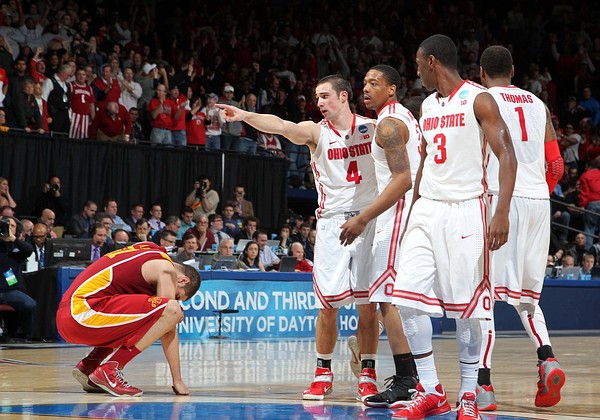BTN.com staff, November 5, 2013
Last season, the Ohio State basketball program just kept on rolling. Its run to the Elite 8 made it four straight seasons that the Buckeyes reached the Sweet Sixteen or beyond. Now, in the final go-round for Aaron Craft, will Ohio State be good enough to do it again?
On the offensive end, the problem is obvious and considerable: replace Deshaun Thomas. Statistically, Thomas was absolutely dominant before leaving for a pro career. He took a full third of Ohio State's shots while he was on the floor, and he rarely left the court. Sure, Thomas was a chucker that didn't create for others, but that's an unjustly-maligned characteristic given that the object of the game is to score more than the other guys. For one thing, chuckers don't usually turn the ball over, and that was a supreme strength of Thomas' game. When you threw him the ball, you pretty much knew it was going towards the basket, and Thomas' 48.6 effective field goal percentage was quite good given that fact. Coupled with his svelte turnover rate, it was enough to put Thomas in the discussion for the most effective offensive player in the nation.
The good news is that the Ohio State roster has a player that, in a lot of ways, looks remarkably similar to Deshaun Thomas. That would be junior forward LaQuinton Ross. Check out the tale of the tape, comparing the two players' Big Ten stats from their sophomore seasons:
| Poss% | Shot% | eFG% | 3PA/FGA | Free Throw Rate | Assist% | TO% | ORtg | |
| Deshaun Thomas, sophomore | 20 | 25 | 56 | 0.29 | 30 | 6 | 7 | 127 |
| LaQuinton Ross, sophomore | 24 | 26 | 54 | 0.34 | 14 | 4 | 25 | 91 |
They look like basically the same guy until you get to the last two columns–Turnover Rate and Offensive Rating. Ross has a serious turnover problem, and that destroys his efficiency. If Ohio State's offense is to avoid a sizable drop-off, LaQuinton Ross will have to be much smarter with the basketball. There's really no excuse for a guy with an assist rate that low to be turning the ball over so much. Ross needs to take a page from the Deshaun Thomas book of chucking–just put the ball up.
On the other side of the ball, things are looking downright scary for Big Ten opponents. Thomas could be charitably described as "disinterested" on the defensive end, so his presence won't be missed at all.
A look at last season's Stops numbers supports this idea (departed players in bold):
| Player | Stops | Minutes | Stops/40 Minutes |
| Ravenel | 64.55 | 311 | 8.30 |
| Williams | 64.41 | 317 | 8.13 |
| Scott | 61.90 | 364 | 6.80 |
| Craft | 105.57 | 643 | 6.57 |
| Smith | 77.25 | 513 | 6.02 |
| Thompson | 65.32 | 451 | 5.79 |
| Thomas | 85.13 | 668 | 5.10 |
| Ross | 29.57 | 264 | 4.48 |
Evan Ravenel's interior defense was solid, but Amir Williams should be prepared to replace it. Williams has flashed elite defensive potential in his first two seasons in Columbus, but he has yet to put it all together. This season, Matta will have no choice but to shovel minutes at Williams, and it figures to be only Williams' propensity for foul trouble that limits his time. If he can stay on the floor, Williams could take this defense up a notch.
Of course, we can't talk about the Ohio State defense without mentioning the real stalwarts. Aaron Craft, Shannon Scott, and Lenzelle Smith comprise what has to be the nation's best trio of perimeter defenders. A bump in minutes for Scott, who played only half of the available Big Ten minutes a season ago, should provide a boost to Ohio State's defense.
All told, this feels like an Ohio State team that is treading water. It's hard to see the offense being as good without Deshaun Thomas, but the defense should improve accordingly.
Fortunately for the Buckeyes, "treading water" would mean another top 10 team, a realistic chance at the Big Ten title, and a team nobody wants to face in March.







